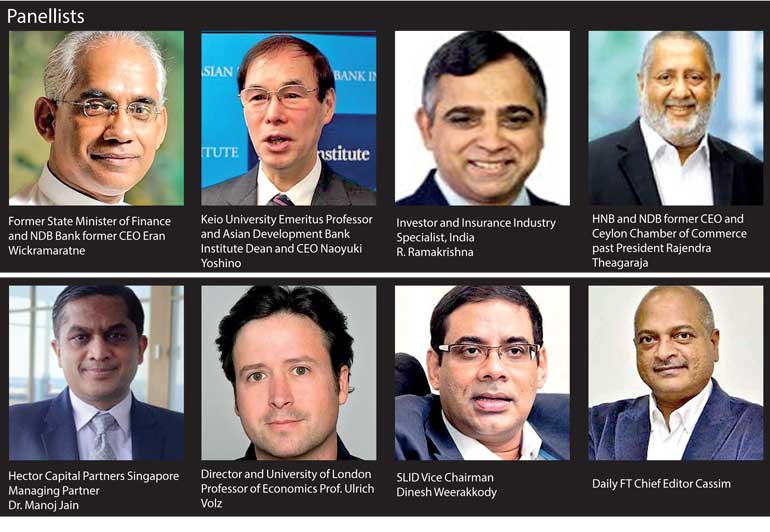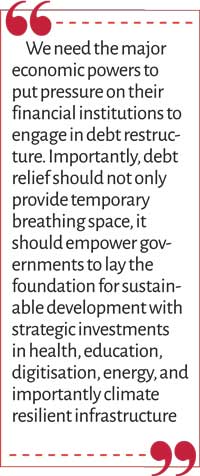Friday Dec 05, 2025
Friday Dec 05, 2025
Wednesday, 29 June 2022 00:00 - - {{hitsCtrl.values.hits}}

Sovereign Debt Restructure Specialist Prof. Lee Buchheit

‘Options for Debt Restructuring in Sri Lanka’ was the chosen theme for a webinar that was organised jointly by the International Chamber of Commerce Sri Lanka and the Daily FT, with the collaboration of the Sri Lanka Institute of Directors (SLID), and the Institute of Chartered Management Accountants (CIMA Sri Lanka), which was broadcast live via Facebook and also reposted for later viewing, in the FB pages of ICC Sri Lanka, and the Daily FT as well as that of CIMA. The program was sponsored by First Capital.
The grave mismanagement of the economy of Sri Lanka has been commented on repeatedly for several months, and the political fallout from the mistakes and poor decisions as well as ‘implementation’ of policy or the opposite therefrom, are glaringly evident. The suffering and grief the population of Lanka have been burdened with, is inescapable and marks the subject matter of just about every news channel and journal.
The webinar was deliberately focused on the ‘options’ available for seeking solutions to mitigate the crushing debt burden, with three broad areas of specificity, namely Legal, Sovereign Debt, and Markets and Investments.
The first of the speakers who addressed the audience was Centre for Sustainable Finance Director and University of London Professor of Economics Prof. Ulrich Volz. His particular focus area is Sovereign Debt.
He points out that the situation in Sri Lanka does impact the future of other developing countries that are also facing a crisis in sovereign debt repayment capacity. As many as 135 countries in the ‘global south’ are in debt, and critically facing issues. The tightening up of US currency is causing a rise in the cost of debt and international refinancing is harder for those countries that maintain a reliance on access to global capital markets. The invasion of Ukraine by Russia’s army has caused the largest commodity shock in modern times. The UN Secretary General was quoted as having warned of an approaching ‘hurricane of hunger’.
If there was a provision that was agreed upon by the G20 nations to engage with crisis-ridden economies, that arrangement ended in December last year. Clearly there is a need for a workable model that is viable and accessible by those economies that are sorely in need of relief through debt-restructure. As of October 2021 the over 60% that Sri Lanka needed to serve was owed to financial markets or private creditors, amounting to around $ 35 billion, and about 8% was owed to the Exim Bank of China. All of which indicates the vital need to bring private creditors to the negotiating table.
Enticing the commercial creditors to engage in debt restructure is envisaged in the proposal of options, and that is by focusing on a Green and Inclusive recovery that could be ‘administered’ by the World Bank. These incentives would back the payment of newly issued sovereign bonds that would be swapped with a significant haircut for old unsustainable privately held debt. Private creditors would benefit from a partial guarantee of the payment of the principal and a part of the interest payment analogous to the Brady Plan that was used effectively in the 1980s.
In terms of ‘pressure’, the financial authorities in the jurisdictions where the major private creditors operate, banks, and asset managers who govern the majority of sovereign debt contracts such as reside in America, UK and China too, would need to use strong moral suasion in regulation and accounting, supervision and taxation to improve the creditors’ ‘willingness’ to participate in debt restructuring. We need the major economic powers to put pressure on their financial institutions to engage in debt restructure. Importantly, debt relief should not only provide temporary breathing space, it should empower governments to lay the foundation for sustainable development with strategic investments in health, education, digitisation, energy, and importantly climate resilient infrastructure.
Hector Capital Partners Singapore Managing Partner Dr. Manoj Jain also addressed the webinar providing a perspective on markets. In particular, he is representing those referred to as ‘private investors’. He averred that the situation is ‘tough’ and is the worst situation faced since 1948 and the first default. Time and the shortfall in essentials as required among the population, adds to the complicated nature of things. Urgency is evident. But where politics and economics overlap, the situation becomes even more difficult to manage successfully. However, building creditor confidence is very important, even as the cash is also required ‘immediately’. This constitutes a ‘test of wills’.
Lots of ‘urgent’ measures are needed for a country to have rescuers coming to their aid. Multilaterals will usually look for the existence of competent teams, and look for strategic interests, which are exactly what will attract them. The teams should employ clear communication as to what will really interest them. They also want to be sure that they are not going to lose their capital if there is a laggard approach to responding to the need for urgent reform. Equally importantly, there must also be clear communication as to what can be done, and what cannot be done with regard to the measures proposed or undertaken.
However, some ‘asset’ sales might be needed. Unfortunately though it is, when an economy hits such a low status, this sort of response becomes a necessity if funds are to be directed into the hard-hit economy. The Asset manager or Investor is keen to ascertain if there are attractive risk-adjusted returns. They will look for diversification, they will be averse to capital loss, rather, will want certainty of income. There are many attendant questions that investors who are willing to participate in the recovery of Sri Lanka, will want clear, unambiguous answers for. How attractive are the assets? When can one ‘exit’? And how does policy impact business? There is no ‘short cut’ in the investor’s process. Diligence is key. A lot he noted depends on what is strategised and offered to the private investors of whom there are many, and who might well wish to participate in the recovery of Sri Lanka.
The third contribution to this webinar was based on the legal aspect of things. Sovereign Debt Restructure Specialist Prof. Lee Buchheit, who is referred to as go to expert for debt ridden nations, had a conversation with SLID Vice Chairman Dinesh Weerakkody. Prof. Buchheit led the international legal teams advising the Hellenic Republic (2011-12) and the Republic of Iraq (2005-08) in their debt restructurings – the two largest sovereign debt workouts in history. He observed that the case of Sri Lanka will be the first sovereign debt restructuring exercise in the world, post-COVID. Notably, this is also a time of the greatest stress in the global financial system. Interest rates are rising. Along with a precipitous rise in commodity prices. Also, shocks to the tourism industry.
Four creditor groups will need to be approached, first, the bond holders. Then the traditional government creditors, also known as the Paris Club which has been around for some decades where several governments plough in their finances to assist with nations that have debt. The largest lender in the Paris Club to Sri Lanka, is Japan. Then there are the bilateral creditors, the largest lender currently being China. India too can be included in this group. Finally, the multilateral creditors e.g. IMF, World Bank, and ADB.
The first three mentioned are somewhat cautious about what is done by others in their category of creditors, which suggests that they are looking to see that any measure of debt relief offered by one group would be seen as requiring that such relief be comparable to what is offered by the other groups. A strange Hobbsian status quo. That is why the challenge will be how to coordinate those groups of creditors. Mention was made of the ‘Common Framework’ selected by the G20, which listed 73 countries for special consideration for debt relief, and which program was started in 2020. However, Sri Lanka is not among the 73, since the island was not categorised as being low-income (poor country), but had been moved into the ‘middle-income’ range.
Prof. Buchheit holds the opinion that even though the ‘Common Framework’ of the G20 countries might not be available, the principle, he argues, might be adapted on the part of the bilateral creditors, when dealing with Sri Lanka to reduce the debt-stock and re-negotiate what is owed. He thought it possible for all creditors to sit together, Paris Club members, and bi-lateral creditors, including China and India could be formed into a committee to review the situation together.
For this to actually take effect, much will depend on the IMF estimation of and assessment of how quickly Sri Lanka can return to a position of debt sustainability. There is a trustee-ship with regard to bond holders, and it is possible that those will persuade the guaranteeing of the payments at maturity. Prof. Buchheit remains optimistic, and notes that the Government of Sri Lanka has obtained the services of the most-able and experienced advisors who are fully cognisant of the challenges.
When asked by Weerakkody, Prof. Lee replied that vital among the ‘Dos’ for Sri Lanka is to maintain transparency when dealing with their creditors. All have a right to know the terms under which debt relief is being considered. He also mentioned that the challenge in this regard involves China, which has chosen bespoke solutions, and they keep their cards close to their collective chest. Turning external debt restructuring into domestic political advantage seeking is often a mistake made by certain countries. That is a definite ‘Don’t’.
On the matter of ‘pain of the restructuring’, Prof. Lee said that it should be ‘shared equally’, but there have to be provisions in place to reduce the burden on the population who are already stressed, and this is one of the things that the IMF must assess. They are the ones who have to analyse the debt sustainability, and then China, for instance, will have to indicate with clarity how much of the debt burden they are going to bear. They will have to decide on a package that will bring Sri Lanka back to a position where they will be able to access the capital market. He did admit that any debt restructuring in any country will be painful, and the message is that it is possible to make it through.
The panel comprised Investor and Insurance Industry Specialist, India R. Ramakrishna, HNB and NDB former CEO and Ceylon Chamber of Commerce past President Rajendra Theagarajah, former State Minister of Finance and NDB Bank former CEO Eran Wickramaratne MP, and Keio University Emeritus Professor and Asian Development Bank Institute Dean and CEO Naoyuki Yoshino.
Initially they were in conversation with Daily FT Chief Editor Nisthar Cassim. Prof. Yoshino revealed that next to Greece, the country that had the highest quantum of debt was Japan. He had been asked to explain in Europe how it is that Japan was able to survive the debt burden. His reply had been that Japan’s domestic savers were investing in government bonds. Whereas two-third of the borrowings by Greece were from overseas. Domestic holdings in government bonds, the professor said, was key to the success in Japan.
Another key factor was that the government created a ‘national balance sheet’ that listed the assets the country had, including all natural resources, mountains, rivers and other natural features, and this was able to create confidence that in fact Japan is ‘rich’. He recommended that Sri Lanka’s government too, create a similar listing of government-held assets. The creditors will be confident that the assets in the island are worth a great deal more than the debt, which will be smaller. This will contribute to the confidence on the part of private investors.
Another factor is that interest rates are very high when funds are borrowed from abroad.
Therefore, it would be prudent to have the IMF and such multilateral institutions to borrow the money and offer temporary relief, while the Government has to make certain that in 10 years that borrowed money will be paid back. Along with these options, there will be the vital need to proceed with a credible 10-year plan. Eran Wickramaratne MP noted the Government used the foreign reserves to pay debts instead of borrowing from the international capital market and servicing debt and used the reserves to artificially control the dollar.
He also noted the need to get bridge finance fast to prevent the public suffering given our import dependency. He further highlighted the need for reforms and the establishment of a debt sustainability baseline. Rajendra Theagrajah noted the State-owned debt in the banking sector and ways of managing the debt. He highlighted the climate sustainability funding options available to Sri Lanka.
Ramakrishna underscored the need of foreign investment in Sri Lanka with something more than manufacturing as central, but also to actively explore the service sector given that there is a talent base available within the island. Also PPP must be the only vehicle for future infrastructure development. The panel’s conclusion was that sovereign debt crises will always be painful, but the lack of a comprehensive framework for restructuring sovereign debt can make them especially difficult to resolve. Sovereign debt owners, therefore might be more willing to address deteriorating debt profiles promptly if they were confident that debt workouts would be negotiated in an orderly manner. This certainly requires competent and committed politicians and professionals to be engaged in this process.